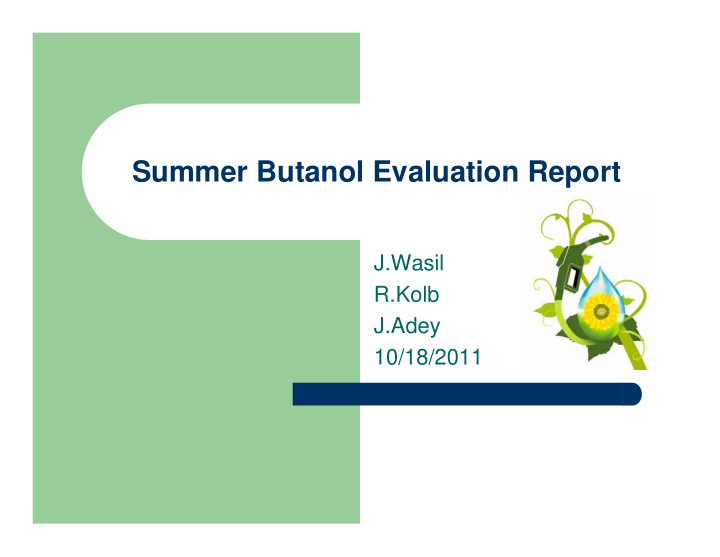



Summer Butanol Evaluation Report J.Wasil R.Kolb J.Adey 10/18/2011
What is Butanol? A four carbon alcohol (C 4 H 9 OH), colorless, neutral liquid of medium volatility with a characteristic banana-like odor. Traditionally petrochemical derived - Generally used to make other chemicals, or used as a solvent or an ingredient in formulated products such as cosmetics.
How is Butanol Made? Can be biologically derived from biomass in a fermentation process using microorganisms – Biobutanol Biobutanol fermentation differs from bioethanol mainly in the use of bacteria. An existing ethanol plant can be converted to make butanol
Butanol Properties: Butanol 99,800 BTU/gallon Gasoline 116,000 BTU/gallon Approximately 86% of the energy content of gasoline Ethanol 76,300 BTU/gallon (68% of the energy content of gasoline)
Butanol Properties: • Phase Separation • As water enters a boat fuel system containing ethanol- extended fuels, phase separation may occur creating an ethanol/water fuel mixture. • Butanol does not phase- Figure 1. Effect of adding 10% separate as shown in the water by volume to 85% ethanol cylinder on the right and 10% water by volume to 85% butanol
Butanol Introduction: Less susceptible to phase separation means butanol could be successfully delivered in existing pipelines Eliminates need for splash-blending Least corrosive of alcohols Higher energy content – can be blended into gasoline at higher percentages than ethanol
Energy Content: 16.1% butanol by volume is equivalent to 10% ethanol by volume ~3% O 2 Energy Content of Butanol-Extended and Ethanol-Extended Fuels 19000 Gasoline 18750 18500 18250 Energy Content [BTU per lb] 18000 Isobutanol 17750 Ethanol 17500 17250 17000 16750 16500 0 2 4 6 8 10 12 14 16 18 20 Alcohol by volume
Why is the nation focused on ethanol? Historically, ethanol fermentation processes resulted in the highest yields Recent advancements in microbial fermentation processes have increased the yields of butanol
Purpose of Testing: To evaluate the effect of butanol-extended fuels in a harsh marine environment and to see if there is a better alternative to ethanol- extended fuels
Test Set-up: On-water emissions testing using the Marine Portable Bag Sampling (MPSS) unit developed for the EPA/NMMA green house gas study.
The Capture
The Boats & Crew
The Boats & Crew
There was a lot of this….
And This…..
Tests Conducted: On-water emissions testing Emissions data reported using EPA certification fuel (non-oxygenated) and 16.1% isobutanol-extended fuel. Values reported in grams per ICOMIA hour: – Total Hydrocarbons – Nitrogen Oxides – Carbon Monoxide
HC + NOx emissions are virtually the same between the two fuels. CO is reduced using isobutanol Test Results: (as expected) ETEC 175 HC, NOx, CO grams per ICOMIA hour Indolene Fuel vs. 16.1% Isobutanol Extended Fuel 4000 3725.3 3500 3086.7 3000 grams / ICOMIA hour 2500 2000 1500 1000 500 224.2 230.3 86.4 57.5 0 THC NOx CO Indolene Isobutanol Evinrude E-TEC 175 Stratified Charged Direct Fuel Injection Two-Stroke on water emissions evaluation [HC, NOx, CO] – 18' Mako Boat. Comparison between Indolene fuel and 16.1% isobutanol extended fuel. Values in grams per ICOMIA hour average of two tests per fuel type
HC decreased slightly and NOx increased slightly using isobutanol…but the total HC+NOx was virtually the same between the two fuels. CO is reduced using Test Results: isobutanol (as expected) JETBOAT HC, NOx, CO grams per ICOMIA hour Indolene Fuel vs. 16.1% Isobutanol Extended Fuel 4000 3470.7 3500 3000 grams / ICOMIA hour 2500 2235.9 2000 1500 1000 500 247.9 208.0 114.0 73.7 0 THC NOx CO Indolene Isobutanol Jet-boat on water emissions evaluation [HC, NOx, CO] – Rotax 1503 Supercharged Four-stroke engine. Comparison between Indolene fuel and 16.1% isobutanol extended fuel. Values in grams per ICOMIA hour average of two tests per test fuel.
Typical Enleanment of E10 relative to non-oxygenated fuel Percent Reduction in Open-loop Engines Mass CO Relative to Baseline Indolene Testing E10 (blue) B16.1 (red) 0 E10 E10 E10 E10 E10 E10 B16.1 B16.1 -5 -10 -15 -17.1 -18.3 -20 -25 -24 16.1% isobutanol -30 similar engine -30.7 -33.1 -35 enleanment as -34.1 -35.6 18% to 40% -40 10% ethanol -40.5 -45 Typical Engine Enleanment Relative to Indolene E-10 vs. B16. E10 engine CO data as reported by DOE (Knoll et al.)
Product Testing
Vintage Tank Testing…..
Coupon testing
Questions? John Adey, ABYC jadey@abycinc.org Jeff Wasil, BRP Jeff.wasil@brp.com Rich Kolb, Volvo-Penta richard.kolb@volvo.com
Recommend
More recommend